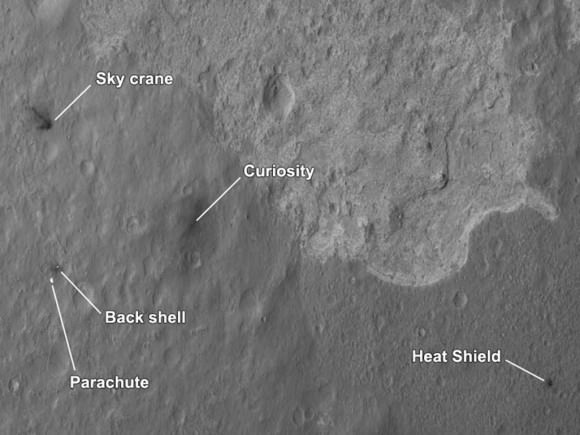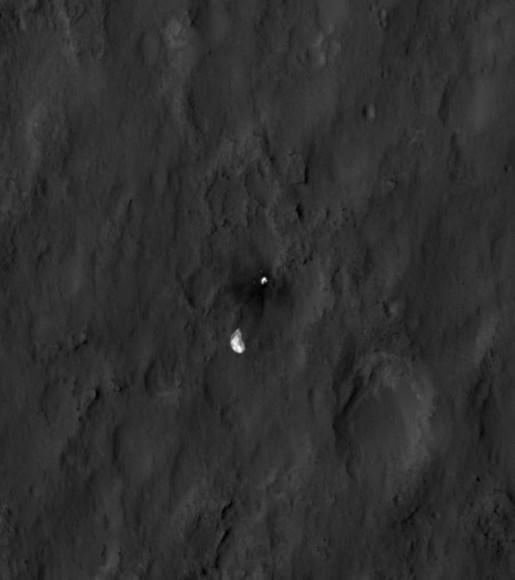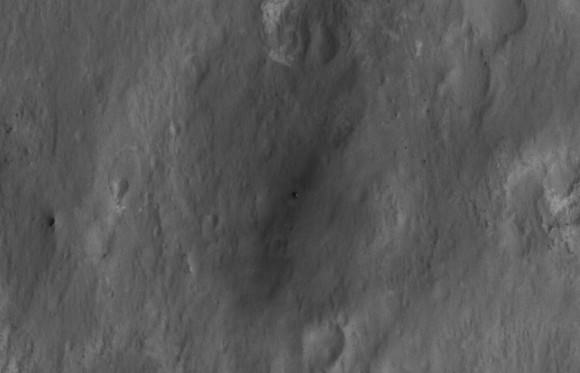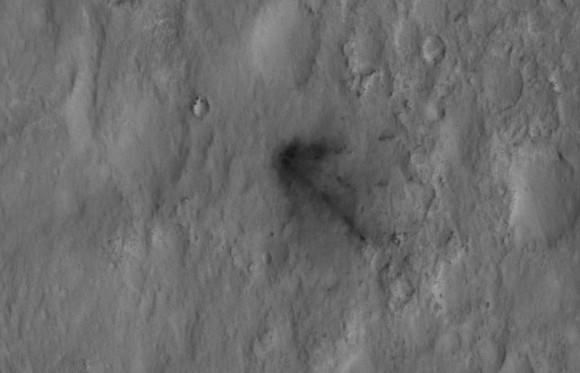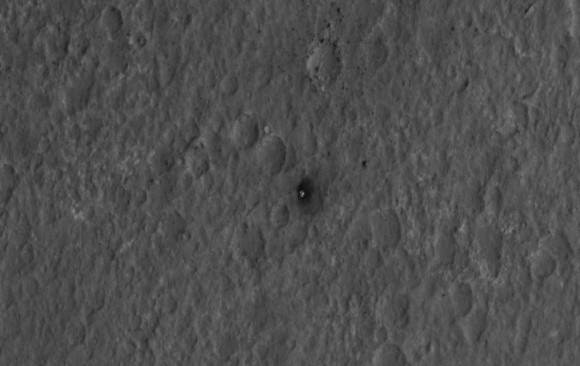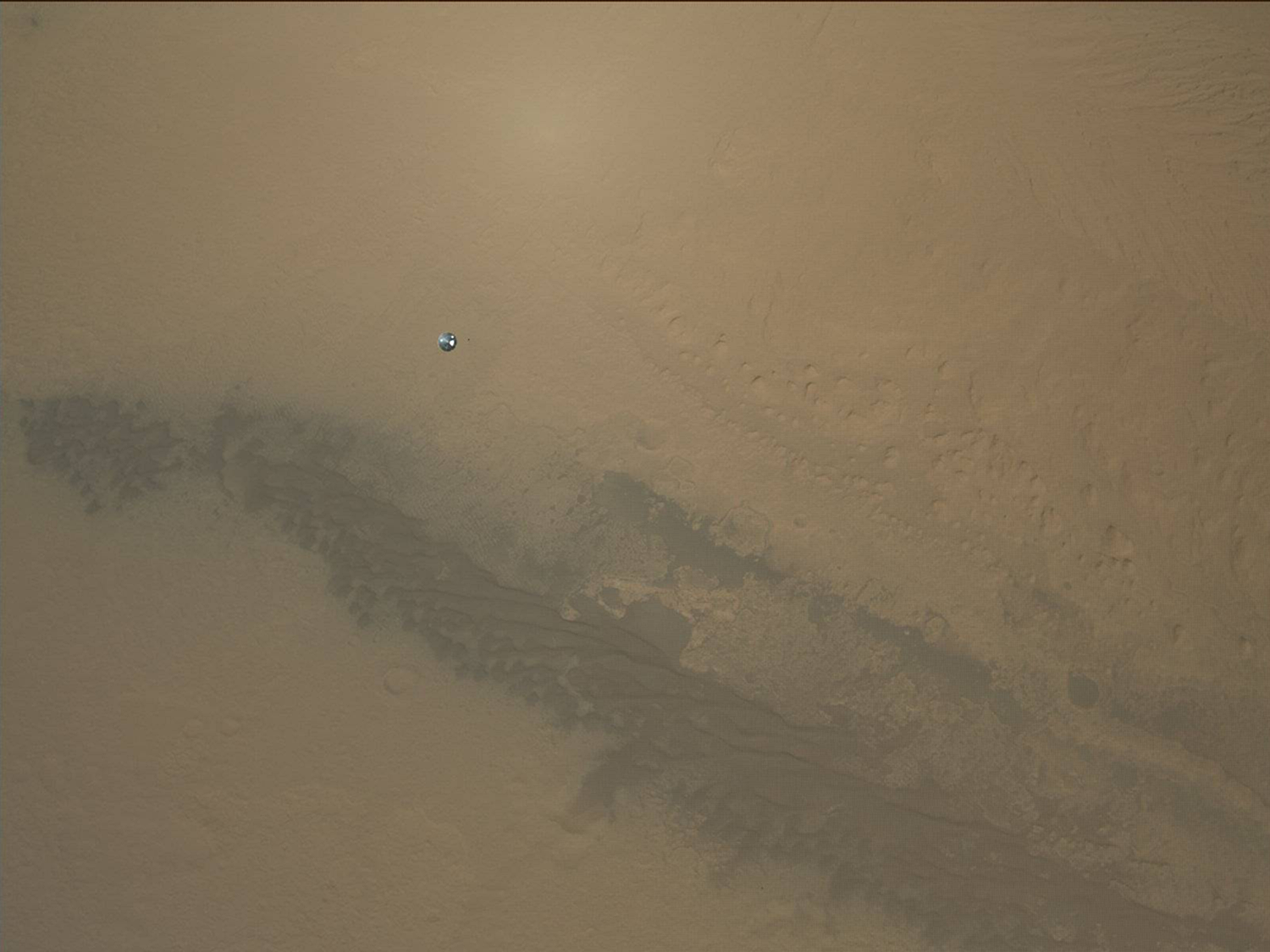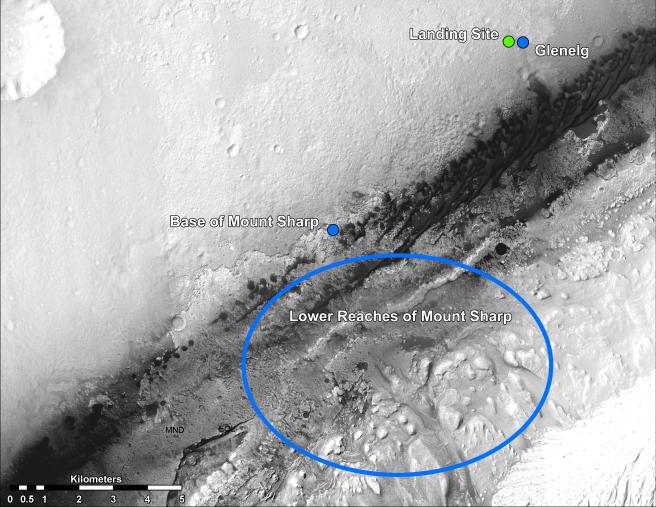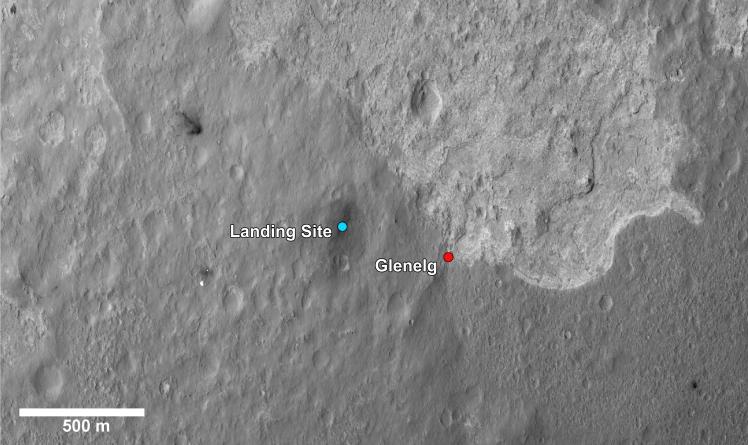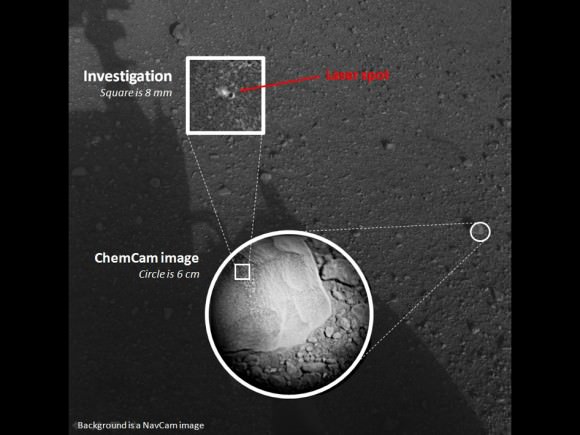Curiosity: Mars Science Laboratory
Re: Curiosity: Mars Science Laboratory
Rover, Sky Crane, Heat Shield and Parachute Located from Orbit by HiRISE
Universe Today | Nancy Atkinson | 2012 Aug 07
The Descent of MSL (Curiosity) Captured by HiRISE: Update II
NASA | JPL-Caltech | Univ of Arizona | HiRISE | 2012 Aug 07
Universe Today | Nancy Atkinson | 2012 Aug 07
The Descent of MSL (Curiosity) Captured by HiRISE: Update II
NASA | JPL-Caltech | Univ of Arizona | HiRISE | 2012 Aug 07
Know the quiet place within your heart and touch the rainbow of possibility; be
alive to the gentle breeze of communication, and please stop being such a jerk. — Garrison Keillor
alive to the gentle breeze of communication, and please stop being such a jerk. — Garrison Keillor
- neufer
- Vacationer at Tralfamadore
- Posts: 18805
- Joined: Mon Jan 21, 2008 1:57 pm
- Location: Alexandria, Virginia
Curiosity's autotomous heat shield falls toward Mars
http://www.planetary.org/blogs/emily-lakdawalla/2012/08072140-msl-mardi-first-full-res.html wrote:
First full-resolution MARDI frame: Bye-bye, heat shield
Posted By Emily Lakdawalla, 2012/08/07 11:50 CDT
Curiosity's heat shield falling toward Mars
A color MARDI image from the descent sequence
shows the heat shield falling far below the rover.
It was taken Sol 0 (2012-08-06 05:15:39 UTC).
NASA / JPL / MSSS / Emily Lakdawalla
Art Neuendorffer
-
APODFORIST
- Ensign
- Posts: 66
- Joined: Sun Jan 02, 2011 4:31 pm
Re: Curiosity: Mars Science Laboratory
I think the dark soil is the color of the soil beneath the surface soil of mars. If you look at the shield,backshell (upon impact with the soil) and even around curiosity the soil is black. For curiosity the darker soil might have been made by the engine of the crane when near the surface. So the dark soil on the crane crash is not residue but the natural color of the undersoil. And yes, i also think the crane went to pieces on impact. At maximum zoom we can see tiny light dot. Are they pieces or not?
-
nexstar114
- Asternaut
- Posts: 8
- Joined: Fri Feb 27, 2009 6:10 am
Re: Curiosity: Mars Science Laboratory
Something I don't understand, so please help me.
I've seen the pictures that Curiosity took of its shadow, both with the lens cover on and off. The rover is pointed southeast toward Mt. Sharp, which is clearly seen in the pictures that were taken from one of the front hazcams.
So why are the front wheels pointed left-to-right instead of straight forward?
The pictures taken from the back of the rover, toward the crater rim to the northwest, show the left rear wheel pointed front-to-back. This I have no problem with.
Thanks for helping.
I've seen the pictures that Curiosity took of its shadow, both with the lens cover on and off. The rover is pointed southeast toward Mt. Sharp, which is clearly seen in the pictures that were taken from one of the front hazcams.
So why are the front wheels pointed left-to-right instead of straight forward?
The pictures taken from the back of the rover, toward the crater rim to the northwest, show the left rear wheel pointed front-to-back. This I have no problem with.
Thanks for helping.
- neufer
- Vacationer at Tralfamadore
- Posts: 18805
- Joined: Mon Jan 21, 2008 1:57 pm
- Location: Alexandria, Virginia
Re: Curiosity: Mars Science Laboratory
I'm sure the wheels are all pointed "front-to-back."nexstar114 wrote:
I've seen the pictures that Curiosity took of its shadow, both with the lens cover on and off. The rover is pointed southeast toward Mt. Sharp, which is clearly seen in the pictures that were taken from one of the front hazcams.
So why are the front wheels pointed left-to-right instead of straight forward?
The pictures taken from the back of the rover, toward the crater rim to the northwest, show the left rear wheel pointed front-to-back. This I have no problem with.
However, things can seem quite distorted in wide angle camera shots.
Art Neuendorffer
-
APODFORIST
- Ensign
- Posts: 66
- Joined: Sun Jan 02, 2011 4:31 pm
Re: Curiosity: Mars Science Laboratory
Maybe the wheels are turned by 45 or more degrees on touchdown - like here: http://www.sen.com/news/curiosity-s-too ... ation.html
Re: Curiosity: Mars Science Laboratory
http://www.nasa.gov/mission_pages/msl/m ... 16012.html
On that self portrait of curiosity these wheels look like they have different angle. May be they are? A full resolution picture will tell for sure.
On that self portrait of curiosity these wheels look like they have different angle. May be they are? A full resolution picture will tell for sure.
Re: Curiosity: Mars Science Laboratory
For those interested, here is a Real Time Light Time distance clock for Mars
http://www.physics.emory.edu/astronomy/ ... /calc.html
http://www.physics.emory.edu/astronomy/ ... /calc.html
- neufer
- Vacationer at Tralfamadore
- Posts: 18805
- Joined: Mon Jan 21, 2008 1:57 pm
- Location: Alexandria, Virginia
Re: Curiosity: Mars Science Laboratory
The stablest landing position would probably be front to back and that's what's shown in the video:Doum wrote:http://www.nasa.gov/mission_pages/msl/m ... 16012.html
On that self portrait of curiosity these wheels look like they have different angle.
May be they are? A full resolution picture will tell for sure.
http://apod.nasa.gov/apod/ap120731.html
Art Neuendorffer
- rstevenson
- Quis custodiet ipsos custodes?
- Posts: 2705
- Joined: Fri Mar 28, 2008 1:24 pm
- Location: Halifax, NS, Canada
Re: Curiosity: Mars Science Laboratory
I like the remark below the calculated values... "This page is for novelty purposes only do not use for navigation."BMAONE23 wrote:For those interested, here is a Real Time Light Time distance clock for Mars
http://www.physics.emory.edu/astronomy/ ... /calc.html
Rob
-
nexstar114
- Asternaut
- Posts: 8
- Joined: Fri Feb 27, 2009 6:10 am
Re: Curiosity: Mars Science Laboratory
Thanks to everyone for your explanation of the orientation of the front wheels as I questioned above.
Now for another question, or perhaps just an observation...........
The new photos from Sol 2 show alot more dust and gravel on the top of the rover than I would have expected. You can tell from the overhead pictures of the landing site that the surface dust was quite disturbed by the sky crane.
I wonder if the people at NASA or JPL expected as much as is shown in the photos, and will it cause any problems?
Thanks.
Now for another question, or perhaps just an observation...........
The new photos from Sol 2 show alot more dust and gravel on the top of the rover than I would have expected. You can tell from the overhead pictures of the landing site that the surface dust was quite disturbed by the sky crane.
I wonder if the people at NASA or JPL expected as much as is shown in the photos, and will it cause any problems?
Thanks.
- geckzilla
- Ocular Digitator
- Posts: 9180
- Joined: Wed Sep 12, 2007 12:42 pm
- Location: Modesto, CA
- Contact:
Re: Curiosity: Mars Science Laboratory
The main problem with the dust with the other two rovers was that it blocked the sun reaching the solar panels. Shouldn't be as big a problem this time around, since it's powered by plutonium decay.
Just call me "geck" because "zilla" is like a last name.
Re: Curiosity: Mars Science Laboratory
Awww... I missed it live, thanks to High Adventure!
The following statement is true.
The above statement is false.
The above statement is false.
JPL: Curiosity Installing Smarts for Driving
NASA Curiosity Mars Rover Installing Smarts for Driving
NASA JPL-Caltech | MSL Curiosity | 2012 Aug 10
Engineering Team Develops Chip for Mars Rover
University of Tennessee, Knoxville | 2012 Aug 07
NASA JPL-Caltech | MSL Curiosity | 2012 Aug 10
NASA's Mars rover Curiosity will spend its first weekend on Mars transitioning to software better suited for tasks ahead, such as driving and using its strong robotic arm.
The rover's "brain transplant," which will occur during a series of steps Aug. 10 through Aug. 13, will install a new version of software on both of the rover's redundant main computers. This software for Mars surface operations was uploaded to the rover's memory during the Mars Science Laboratory spacecraft's flight from Earth.
"We designed the mission from the start to be able to upgrade the software as needed for different phases of the mission," said Ben Cichy of NASA's Jet Propulsion Laboratory in Pasadena, Calif., chief software engineer for the Mars Science Laboratory mission. "The flight software version Curiosity currently is using was really focused on landing the vehicle. It includes many capabilities we just don't need any more. It gives us basic capabilities for operating the rover on the surface, but we have planned all along to switch over after landing to a version of flight software that is really optimized for surface operations."
A key capability in the new version is image processing to check for obstacles. This allows for longer drives by giving the rover more autonomy to identify and avoid potential hazards and drive along a safe path the rover identifies for itself. Other new capabilities facilitate use of the tools at the end of the rover's robotic arm.
While Curiosity is completing the software transition, the mission's science team is continuing to analyze images the rover has taken of its surroundings inside Gale Crater. Researchers are discussing which features in the scene to investigate after a few weeks of initial checkouts and observations to assess equipment on the rover and characteristics of the landing site.
The Mars Science Laboratory spacecraft delivered Curiosity to its target area on Mars at 10:31:45 p.m. PDT on Aug. 5 (1:31:45 a.m. EDT on Aug. 6), which includes the 13.8 minutes needed for confirmation of the touchdown to be radioed to Earth at the speed of light.
Curiosity carries 10 science instruments with a total mass 15 times as large as the science payloads on NASA's Mars rovers Spirit and Opportunity. Some of the tools, such as a laser-firing instrument for checking rocks' elemental composition from a distance, are the first of their kind on Mars. Curiosity will use a drill and scoop, which are located at the end of its robotic arm, to gather soil and powdered samples of rock interiors, then sieve and parcel out these samples into the rover's analytical laboratory instruments.
To handle this science toolkit, Curiosity is twice as long and five times as heavy as Spirit or Opportunity. The Gale Crater landing site at 4.59 degrees south, 137.44 degrees east, places the rover within driving distance of layers of the crater's interior mountain. Observations from orbit have identified clay and sulfate minerals in the lower layers, indicating a wet history.
Engineering Team Develops Chip for Mars Rover
University of Tennessee, Knoxville | 2012 Aug 07
Know the quiet place within your heart and touch the rainbow of possibility; be
alive to the gentle breeze of communication, and please stop being such a jerk. — Garrison Keillor
alive to the gentle breeze of communication, and please stop being such a jerk. — Garrison Keillor
- neufer
- Vacationer at Tralfamadore
- Posts: 18805
- Joined: Mon Jan 21, 2008 1:57 pm
- Location: Alexandria, Virginia
Re: JPL: Curiosity Installing Smarts for Driving
bystander wrote:NASA Curiosity Mars Rover Installing Smarts for Driving
NASA JPL-Caltech | MSL Curiosity | 2012 Aug 10
http://www.space.com/17053-mars-rover-curiosity-software-update.html wrote:Mars Rover Curiosity to Receive 'Brain Transplant'Click to play embedded YouTube video.
by Mike Wall, SPACE.com Senior Writer, 10 August 2012
<<NASA's Mars rover Curiosity will begin a "brain transplant" tomorrow (Aug. 11), a four-day operation that will bring a temporary halt to the robot's science activities. "This is primarily an engineering activity," Curiosity lead flight software engineer Ben Cichy, of NASA's Jet Propulsion Laboratory in Pasadena, Calif., told reporters. "So we are mostly focusing on just getting done with the engineering and doing the installation, and standing down on science for the next four Sols."
The MSL team calls the flight software that guided the daring touchdown R9. With Curiosity now safely on the surface, it's time to switch over to R10, which was uploaded during the rover's eight-month interplanetary cruise. R10 will allow Curiosity to get the full use out of its 10 science instruments and its 7-foot-long, drill-equipped robotic arm, Cichy said. And the software upgrade will let the six-wheeled robot roam — more or less autonomously, if its handlers wish — around the Gale Crater area. "Curiosity was born to drive," Cichy said. "The R10 software includes the capability for Curiosity to really get out and stretch her wheels on the surface of Mars."
Software upgrades like this one are necessary in part because Curiosity's computing power is relatively low compared with what we're used to on Earth, a consequence of the tradeoffs required to toughen the rover up for the rigors of launch, flight, landing and Mars surface operations.
For example, Curiosity's two processors — one each in its main and backup computers — run at 133 megahertz, Cichy said. That's about 10 times slower than the processors found in typical smartphones. And the rover has about 4 gigabytes of storage capacity, compared with 64 gigs or so for a smartphone.Transitioning to R10 frees up this limited computing power by taking the landing package out of the mix. "It's like closing a few applications on your computer, and 'Wow, the whole thing runs faster, and now I can drive,'" Cichy said.
The switch to R10 will take a while. It starts with a "toe dip" on Curiosity's main computer on Sol 5 (which itself begins around 0230 GMT Saturday). If everything looks good, the MSL team will commit to a full installation on Sol 6, Cichy said. The process will repeat on Sols 7 and 8 on Curiosity's backup computer.
Curiosity is slated to roam around the Gale Crater area for the next two years or more, attempting to determine if Mars can, or ever could, support microbial life. So a four-day halt on science activities doesn't amount to much in the grand scheme of the mission. And R10 is worth the wait, Cichy said. "It has a lot of great stuff that the science team wants, that the surface team wants, in order to enable this fantastic mission," he said. "And so that's why we're willing to spend some time here doing the install.">>
Art Neuendorffer
JPL: Orbiter Views NASA's New Mars Rover in Color
Orbiter Views NASA's New Mars Rover in Color
NASA | JPL-Caltech | MSL | 2012 Aug 14
What Curiosity Looks Like From 200 Kilometers Up
Universe Today | Jason Major | 2012 Aug 14
Mars Orbiting Paparazzi Spies Curiosity's Domain
Discovery News | Big Pic | 2012 Aug 14
Curiosity’s looking a little blue
Discover Blogs | Bad Astronomy | 2012 Aug 14
NASA | JPL-Caltech | MSL | 2012 Aug 14
The first color image taken from orbit showing NASA's rover Curiosity on Mars includes details of the layered bedrock on the floor of Gale Crater that the rover is beginning to investigate.
Operators of the High Resolution Imaging Science Experiment (HiRISE) camera on NASA's Mars Reconnaissance Orbiter added the color view to earlier observations of Curiosity descending on its parachute, and one day after landing.
"The rover appears as double bright spot plus shadows from this perspective, looking at its shadowed side, set in the middle of the blast pattern from the descent stage," said HiRISE Principal Investigator Alfred McEwen, of the University of Arizona, Tucson. "This image was acquired from an angle looking 30 degrees westward of straight down. We plan to get one in a few days looking more directly down, showing the rover in more detail and completing a stereo pair."
Meanwhile, Curiosity has finished a four-day process transitioning both of its redundant main computers to flight software for driving and using tools on the rover's arm. During the latter part of the Mars Science Laboratory spacecraft's 36-week flight to Mars and its complicated descent to deliver Curiosity to the Martian surface on Aug. 5, PDT (Aug. 6, EDT and Universal Time), the rover's computers used a version of flight software with many capabilities no longer needed. The new version expands capabilities for work the rover will do now that it is on Mars.
"We have successfully completed the brain transplant," said Curiosity Mission Manager Mike Watkins of NASA's Jet Propulsion Laboratory, Pasadena, Calif. "Now we are moving on to a new phase of functional checkouts of the science instruments and preparations for a short test drive."
The first drive, possibly within a week or so, will likely include short forward and reverse segments and a turn. Curiosity has a separate drive motor on each of its six wheels and steering motors on the four corner wheels. Preparation and testing of the motor controllers will precede the first drive.
After the test drive, the planning schedule has an "intermission" before a second testing phase focused on use of the rover's robotic arm. For the intermission, the 400-member science team will have the opportunity to pick a location for Curiosity to drive to before the arm-testing weeks.
"It's fair to say that the scientists, not to mention the rover drivers, are itching to move," said JPL's Ashwin Vasavada, deputy project scientist for Curiosity.
Researchers have been examining images from Curiosity's cameras and HiRISE to identify potential targets to investigate near the rover and on the visible slope of the nearby three-mile-high mound informally named Mount Sharp.
"The science and operations teams are evaluating several potential routes that would take us to Mount Sharp, with perhaps a few waypoints to inspect some of the different terrains we've identified as we map the landing area," Vasavada said. "As we have reported many times before, it's going to take us a good part of our first year to make it to the layered sediments on Mount Sharp."
During a prime mission of nearly two years, researchers will use Curiosity to investigate whether the selected area of Mars has ever offered chemical ingredients for life and other environmental conditions favorable for supporting microbial life. Curiosity carries 10 science instruments with a total mass 15 times as large as the science payloads on NASA's Mars rovers Spirit and Opportunity.
To handle this science toolkit, Curiosity is twice as long and five times as heavy as Spirit or Opportunity. The landing site inside Gale Crater places the rover within driving distance of layers of Mount Sharp. Observations from orbit have identified clay and sulfate minerals in the lower layers, indicating a wet history.
What Curiosity Looks Like From 200 Kilometers Up
Universe Today | Jason Major | 2012 Aug 14
Mars Orbiting Paparazzi Spies Curiosity's Domain
Discovery News | Big Pic | 2012 Aug 14
Curiosity’s looking a little blue
Discover Blogs | Bad Astronomy | 2012 Aug 14
Know the quiet place within your heart and touch the rainbow of possibility; be
alive to the gentle breeze of communication, and please stop being such a jerk. — Garrison Keillor
alive to the gentle breeze of communication, and please stop being such a jerk. — Garrison Keillor
Re: JPL: Curiosity Installing Smarts for Driving
bystander wrote:NASA Curiosity Mars Rover Installing Smarts for Driving
NASA JPL-Caltech | MSL Curiosity | 2012 Aug 10
Curiosity Getting Ready to Roveneufer wrote:Mars Rover Curiosity to Receive 'Brain Transplant'
by Mike Wall, SPACE.com Senior Writer, 10 August 2012
Universe Today | Nancy Atkinson | 2012 Aug 14
Curiosity Ready to Drive After 'Brain Surgery'
Discovery News | via Mike Wall, SPACE.com | 2012 Aug 14
Know the quiet place within your heart and touch the rainbow of possibility; be
alive to the gentle breeze of communication, and please stop being such a jerk. — Garrison Keillor
alive to the gentle breeze of communication, and please stop being such a jerk. — Garrison Keillor
Curiosity's 'Voice' During Descent
Scientist's have compressed Curiosity's descent signals into an audible (but rather noisey) 'voice', and matched it to a video of the landing sequence.
Click here to see & hear it. It plays twice. http://www.space.com/17110-screaming-do ... video.html
Click here to see & hear it. It plays twice. http://www.space.com/17110-screaming-do ... video.html
To find the Truth, you must go Beyond.
Science@NASA: Where Will Curiosity Go First?
Where Will Curiosity Go First?
NASA Science News | Dauna D. Coulter | 2012 Aug 17
Curiosity Team Pinpoints Site for First Drive
NASA | JPL-Caltech | 2012 Aug 17
Decision to drive to "the high thermal inertia unit" and what that means
Planetary Society | Emily Lakdawalla | 2012 Aug 17
ChemCam laser sets its sights on first Martian target
Los Alamos National Laboratory | 2012 Aug 17
1st Laser Firing and 1st Motion Imminent for Curiosity
Universe Today | Ken Kremer | 2012 Aug 18
NASA Science News | Dauna D. Coulter | 2012 Aug 17
By now it's old news that NASA's new Mars rover Curiosity is resting safely on the surface of Red Planet after a daredevil landing that had the nation holding its breath. Now, mission scientists are anxious to start moving. With such a sweet set of wheels at their disposal and the "open road" before them, just where will they go first?Click to play embedded YouTube video.
"We won't have to travel far for excitement," says project scientist John Grotzinger. "We landed in the best possible place within the landing ellipse -- the bottom of an alluvial fan."
An alluvial fan is a pattern of sedimentary rocks, dirt, and sand deposited by flowing water – in this case, perhaps an ancient Martian river. Since life as we know it requires liquid water, this is an excellent first place to search for clues of a Mars that was once hospitable to life.
"The alluvial fan indicates that water flowed across the surface, so we'll head downhill to where water might have collected. We'll be looking for minerals like salts that might tell us where water has been. It's kind of like a scavenger hunt with minerals as clues."
After that, Grotzinger says it's "full-speed ahead" to the base of Mount Sharp, a 5000-meter tall mountain that holds within its ancient layers possible clues to life on the Red Planet.
"We'll have to make a deal with ourselves not to stop too often along the way. Mount Sharp is the reason we chose this landing site, so we need to high-tail it on over there."
Deputy Program Manager Richard Cook describes the temptation to stop along the way: "It'll be like taking a family vacation, but instead of the family you have 400 scientists who want to stop and look at every sight."
Curiosity is bristling with instruments custom-made to look for the chemical building blocks of life.
A laser on Curiosity's mast can take aim at interesting rocks and vaporize small spots on them from up to 7 meters away. The micro-blasts produce plasma clouds, and the scientists can examine the light reflected off these clouds to learn what the rocks are made of. The mast also sports a high-resolution camera called Mastcam, which has already begun observing and photographing the rover's surroundings.
The rover's robotic arm wields its own array of instruments. The Alpha Particle X-Ray Spectrometer will measure the abundance of chemical elements in the dust, soils, rocks, and samples the rover gathers. The Mars Hand Lens Imager acts like a geologist's magnifying lens that can take its own color photos.
Ultimately samples will be delivered to a pair of onboard laboratory instruments. One of them, SAM, short for Sample Analysis at Mars, will explore the Red Planet by 'sniffing' the air, bird-dog style. It has vents that open to the atmosphere to detect gases like methane. SAM can also 'sniff' the gases released by rock or soil samples it heats in its own oven.
Can 400 scientists gripped by the thrill of the greatest 'family vacation' ever really rush to their destination without stopping to savor every sight?
Grotzinger makes just one guarantee: "In the coming months and years, Curiosity will tell us an incredible story."
Curiosity Team Pinpoints Site for First Drive
NASA | JPL-Caltech | 2012 Aug 17
The scientists and engineers of NASA's Curiosity rover mission have selected the first driving destination for their one-ton, six-wheeled mobile Mars laboratory. The target area, named Glenelg, is a natural intersection of three kinds of terrain. The choice was described by Curiosity Principal Investigator John Grotzinger of the California Institute of Technology during a media teleconference on Aug. 17.
"With such a great landing spot in Gale Crater, we literally had every degree of the compass to choose from for our first drive," Grotzinger said. "We had a bunch of strong contenders. It is the kind of dilemma planetary scientists dream of, but you can only go one place for the first drilling for a rock sample on Mars. That first drilling will be a huge moment in the history of Mars exploration."
The trek to Glenelg will send the rover 1,300 feet (400 meters) east-southeast of its landing site. One of the three types of terrain intersecting at Glenelg is layered bedrock, which is attractive as the first drilling target.
"We're about ready to load our new destination into our GPS and head out onto the open road," Grotzinger said. "Our challenge is there is no GPS on Mars, so we have a roomful of rover-driver engineers providing our turn-by-turn navigation for us."
Prior to the rover's trip to Glenelg, the team in charge of Curiosity's Chemistry and Camera instrument, or ChemCam, is planning to give their mast-mounted, rock-zapping laser and telescope combination a thorough checkout. On Saturday night, Aug. 18, ChemCam is expected to "zap" its first rock in the name of planetary science. It will be the first time such a powerful laser has been used on the surface of another world.
"Rock N165 looks like your typical Mars rock, about three inches wide. It's about 10 feet away," said Roger Wiens, principal investigator of the ChemCam instrument from the Los Alamos National Laboratory in New Mexico. "We are going to hit it with 14 millijoules of energy 30 times in 10 seconds. It is not only going to be an excellent test of our system, it should be pretty cool too."
Mission engineers are devoting more time to planning the first roll of Curiosity. In the coming days, the rover will exercise each of its four steerable (front and back) wheels, turning each of them side-to-side before ending up with each wheel pointing straight ahead. On a later day, the rover will drive forward about one rover-length (10 feet, or 3 meters), turn 90 degrees, and then kick into reverse for about 7 feet (2 meters).
"There will be a lot of important firsts that will be taking place for Curiosity over the next few weeks, but the first motion of its wheels, the first time our roving laboratory on Mars does some actual roving, that will be something special," said Michael Watkins, mission manager for Curiosity from the Jet Propulsion Laboratory in Pasadena, Calif.
Decision to drive to "the high thermal inertia unit" and what that means
Planetary Society | Emily Lakdawalla | 2012 Aug 17
[img3="Curiosity's first destination: Glenelg - Credit: NASA/JPL/UA/Emily LakdawallaAs I post this blog entry, it's just past midnight, in the wee hours of sol 12 for Curiosity on Mars. Back on Earth, there was a phone briefing this morning. The biggest news: according to project scientist John Grotzinger, the team has "pretty well decided" on Curiosity's first science target: the "triple junction" of three different rock types located a little more than 400 meters to the east of the rover's current position. They've named the spot "Glenelg."
A cropped view of a HiRISE image taken 6 days after Curiosity landed includes a "triple junction" of three different rock types. The team named that spot "Glenelg" and planned to make that Curiosity's first driving destination. The rover is visible at far left, surrounded by a dark splash where its landing jets disturbed the dust. "]https://planetary.s3.amazonaws.com/asse ... elg840.jpg[/img3]
Here is a view of the triple junction, cropped from the fantabulous HiRISE image taken 6 days after landing. I have stretched the heck out of the color to make the distinction among the three surface units easy to see. There is the reddish one, on which Curiosity sits; a light-toned one, occupying the top right quadrant; and a bluish one occupying the lower right quadrant. This isn't true color, but the relative color is correct -- one is redder, one is brighter, one is bluer.
The lightest unit in the image above is a rock type that's being referred to as "the high thermal inertia unit." I think it's time I explained what that means and why it's important.
Thermal inertia is a physical property of a material. If you know what "inertia" means, "thermal inertia" is exactly what it sounds like: a measure of the material's resistance to changes in temperature. Generally speaking, rocks and water have high thermal inertia. Dust and soil, with their large surface area relative to volume, have low thermal inertia.
Mars experiences wide swings in temperature because it lacks much of an atmosphere. The temperature at Curiosity's landing site varies by about 80 degrees Celsius or Kelvin each day-night cycle. A material that has high thermal inertia hangs on to its heat overnight, so if you look at Mars at night with a thermal imaging system, dark areas are dusty and bright areas are rocky. (This is, of course, an oversimplification, but it's a good first approximation of what nighttime thermal imaging data means.)
So here is a blink gif comparing what Gale looks like in daytime and nighttime infrared, as seen by the Thermal Emission Imaging System (THEMIS) on Mars Odyssey. The shading in daytime thermal imaging is dominated primarily by solar heating, so it looks like a regular photo in most places. It's easy to recognize the mound in the daytime infrared, but nighttime infrared is freaky-looking! It took me a while even to figure out what I was looking at -- in fact, that's why the daytime infrared image is there, to help me locate myself. I have put a little yellow square where Curiosity landed.
Mars experiences wide swings in temperature because it lacks much of an atmosphere. The temperature at Curiosity's landing site varies by about 80 degrees Celsius or Kelvin each day-night cycle. A material that has high thermal inertia hangs on to its heat overnight, so if you look at Mars at night with a thermal imaging system, dark areas are dusty and bright areas are rocky. (This is, of course, an oversimplification, but it's a good first approximation of what nighttime thermal imaging data means.)
So here is a blink gif comparing what Gale looks like in daytime and nighttime infrared, as seen by the Thermal Emission Imaging System (THEMIS) on Mars Odyssey. The shading in daytime thermal imaging is dominated primarily by solar heating, so it looks like a regular photo in most places. It's easy to recognize the mound in the daytime infrared, but nighttime infrared is freaky-looking! It took me a while even to figure out what I was looking at -- in fact, that's why the daytime infrared image is there, to help me locate myself. I have put a little yellow square where Curiosity landed.
Okay. What does this tell us? In the nighttime infrared image you should be able to see, immediately north of Curiosity, a light-colored splash on the Gale crater floor. Notably, it's a somewhat darkish area in the daytime infrared. This is an area of high thermal inertia, resistant to changes in temperature: it's warm at night, and cool during the day.
To put it in its geological context, look to the northwest of Curiosity. You will see a beautiful branching channel system, that once collected flowing water from higher elevations and channeled it into Gale crater. Where it breaks out of the crater rim it develops a mildly sinuous pattern, and it ends in a fan-shaped sedimentary deposit. This is an "alluvial fan." The water in the channel system ran swiftly in the steeply sloped terrain on the crater rim and so was able to carry rocks along with it. As soon as the channel debouched onto the crater floor, it flowed with much less speed so couldn't carry that heavy material anymore; the sediment fell out of the water, with the biggest cobbles being dropped closest to the wall. The finest clays continued to be suspended in the water until it flowed no more, so were left at the end of the fan. That's clay-rich material deposited out of flowing water -- exactly the kind of environment Curiosity was sent to Mars to study. That high-thermal-inertia unit may be a rock formed out of those fine clays.
On the other hand, it might not be. We're going to find out one way or the other, because that's where Curiosity is headed as soon as she starts driving.
Here's a few other bullet-point updates from today's briefing.
If 3 or 4 weeks seems like a long time for a 400-meter drive, it's because you're used to Opportunity's ridiculous one-sol drives of more than 100 meters. Remember, she was not doing that until way after her primary mission had ended, after her drivers had gotten very confident handling her on the repetitive, incredibly flat terrain of Meridiani planum. It's possible that Curiosity will never achieve drives of that length, because all her flat-terrain driving is going to be early in the primary mission, when the drivers won't have achieved that confidence yet. By the time the driving becomes truly comfortable (though not easy -- it's never easy driving a rover on Mars!), Curiosity might already be in the much steeper terrain near the mound, and such long drives may not be possible.
- They'll start the drive after finishing Commissioning Activity Period 1B, during the so-called "Intermission." That's some time after next week. If they drive straight, it'll take 3 to 4 weeks to get there. (Go here for an explanation of what the Commissioning Activity Phases are.)
- However, they might interrupt the drive to perform Commissioning Activity Period 2 activities if they spy an area of nice fine-grained material that will be straightforward to pick up and deliver to the SAM and CheMin laboratory instruments.
- The DAN instrument operated successfully in active mode today, firing neutrons at the ground; furthermore, the RAD instrument detected the operation of DAN as expected. Grotzinger called this "great team collaboration."
- The REMS weather instrument is operating and Grotzinger promised that its principal investigator would present the first results from that next week. The current daily maximum temperature is 276 Kelvin (3 degrees Celsius, 37 degrees Fahrenheit).
- Roger Wiens showed an image of a little rock that the ChemCam team has picked out for their first shot, chosen more for its suitability for target practice than for science.
- I asked about the Mastcam-100 (the zoom one) and they do not plan to go through their initial pointing tests and so forth until after Commissioning Activity Period 1B is complete.
- They have not yet sequenced Mastcam-34 views that reach the top of the mound.
Of course, I could be selling the rover drivers short here. For any rover drivers reading this, yes, that's a challenge. Achieve an over 100-meter drive with Curiosity and I'll bake you some cookies!
ChemCam laser sets its sights on first Martian target
Los Alamos National Laboratory | 2012 Aug 17
1st Laser Firing and 1st Motion Imminent for Curiosity
Universe Today | Ken Kremer | 2012 Aug 18
Know the quiet place within your heart and touch the rainbow of possibility; be
alive to the gentle breeze of communication, and please stop being such a jerk. — Garrison Keillor
alive to the gentle breeze of communication, and please stop being such a jerk. — Garrison Keillor
Rover's Laser Instrument Zaps First Martian Rock Report
Rover's Laser Instrument Zaps First Martian Rock
NASA | JPL-Caltech | MSL | 2012 Aug 19
NASA | JPL-Caltech | MSL | 2012 Aug 19
[img3="ChemCam fired its laser at the fist-sized rock, called "Coronation" (previously "N165"), with the purpose of analyzing the glowing, ionized gas, called plasma, that the laser excites. (Credit: NASA/JPL-Caltech/MSSS)"]http://www.jpl.nasa.gov/images/msl/2012 ... er-640.jpg[/img3]Today, NASA's Mars rover Curiosity fired its laser for the first time on Mars, using the beam from a science instrument to interrogate a fist-size rock called "Coronation."
The mission's Chemistry and Camera instrument, or ChemCam, hit the fist-sized rock with 30 pulses of its laser during a 10-second period. Each pulse delivers more than a million watts of power for about five one-billionths of a second.
The energy from the laser excites atoms in the rock into an ionized, glowing plasma. ChemCam catches the light from that spark with a telescope and analyzes it with three spectrometers for information about what elements are in the target.
"We got a great spectrum of Coronation -- lots of signal," said ChemCam Principal Investigator Roger Wiens of Los Alamos National Laboratory, N.M. "Our team is both thrilled and working hard, looking at the results. After eight years building the instrument, it's payoff time!"
ChemCam recorded spectra from the laser-induced spark at each of the 30 pulses. The goal of this initial use of the laser on Mars was to serve as target practice for characterizing the instrument, but the activity may provide additional value. Researchers will check whether the composition changed as the pulses progressed. If it did change, that could indicate dust or other surface material being penetrated to reveal different composition beneath the surface. The spectrometers record intensity at 6,144 different wavelengths of ultraviolet, visible and infrared light.
"It's surprising that the data are even better than we ever had during tests on Earth, in signal-to-noise ratio," said ChemCam Deputy Project Scientist Sylvestre Maurice of the Institut de Recherche en Astrophysique et Planetologie (IRAP) in Toulouse, France. "It's so rich, we can expect great science from investigating what might be thousands of targets with ChemCam in the next two years."
The technique used by ChemCam, called laser-induced breakdown spectroscopy, has been used to determine composition of targets in other extreme environments, such as inside nuclear reactors and on the sea floor, and has had experimental applications in environmental monitoring and cancer detection. Today's investigation of Coronation is the first use of the technique in interplanetary exploration.
Know the quiet place within your heart and touch the rainbow of possibility; be
alive to the gentle breeze of communication, and please stop being such a jerk. — Garrison Keillor
alive to the gentle breeze of communication, and please stop being such a jerk. — Garrison Keillor
- neufer
- Vacationer at Tralfamadore
- Posts: 18805
- Joined: Mon Jan 21, 2008 1:57 pm
- Location: Alexandria, Virginia
Re: Curiosity: Mars Science Laboratory
http://www.universetoday.com/96901/curiosity-blasts-1st-mars-rock-with-powerful-laser-zapper/#ixzz2436NN2ZV wrote:Curiosity Blasts 1st Mars Rock with Powerful Laser Zapper
- [b][color=#0000FF]Image Caption: PewPew !! – First Laser Zapped rock on Mars. This composite image, with magnified insets, depicts the first laser test by the Chemistry and Camera, or ChemCam, instrument aboard NASA’s Curiosity Mars rover. The composite incorporates a Navigation Camera image taken prior to the test, with insets taken by the camera in ChemCam. The circular insert highlights the rock before the laser test. The square inset is further magnified and processed to show the difference between images taken before and after the laser interrogation of the fist-sized rock, called “Coronation.” Credit: NASA/JPL-Caltech/LANL/CNES/IRAP[/color][/b]
by Ken Kremer on August 20, 2012
<<NASA’s Curiosity rover successfully blasted a Mars rock with a powerful laser beam, for the first time in history, today Aug. 19, inaugurating a revolutionary new era in planetary science with a new type of instrument that will deliver bountiful discoveries. The fist sized Martian rock zapped during the maiden laser target practice shots was appropriately dubbed “Coronation”.
The ChemCam instrument mounted at the top of Curiosity’s mast fired a total of 30 one-million watt pulses over a 10 second period at the 3 inch wide rock that vaporized a pinhead sized spot into an ionized, glowing plasma.
Each pulse lasted about five one-billionths of a second and was sufficient in energy to generate a spark of plasma to be observed with the ChemCam telescope and trio of spectrometers below deck in order to identify the elemental composition.
“Yes, I’ve got a laser beam attached to my head. I’m not ill tempered; I zapped a rock for science. PewPew,” tweeted Curiosity.
“We got a great spectrum of Coronation — lots of signal,” said ChemCam Principal Investigator Roger Wiens of Los Alamos National Laboratory, N.M. “Our team is both thrilled and working hard, looking at the results. After eight years building the instrument, it’s payoff time!”>>
Art Neuendorffer
Curiosity Stretches its Arm
Curiosity Stretches its Arm
NASA | JPL-Caltech | MSL | 2012 Aug 20
NASA | JPL-Caltech | MSL | 2012 Aug 20
NASA's Mars rover Curiosity flexed its robotic arm today for the first time since before launch in November 2011.
The 7-foot-long (2.1-meter-long) arm maneuvers a turret of tools including a camera, a drill, a spectrometer, a scoop and mechanisms for sieving and portioning samples of powdered rock and soil.
"We have had to sit tight for the first two weeks since landing, while other parts of the rover were checked out, so to see the arm extended in these images is a huge moment for us," said Matt Robinson of NASA's Jet Propulsion Laboratory, lead engineer for Curiosity's robotic arm testing and operations. "The arm is how we are going to get samples into the laboratory instruments and how we place other instruments onto surface targets."
Weeks of testing and calibrating arm movements are ahead before the arm delivers a first sample of Martian soil to instruments inside the rover. Monday's maneuver checked motors and joints by unstowing the arm for the first time, extending it forward using all five joints, then stowing it again in preparation for the rover's first drive.
"It worked just as we planned," said JPL's Louise Jandura, sample system chief engineer for Curiosity. "From telemetry and from the images received this morning, we can confirm that the arm went to the positions we commanded it to go to."
The turret has a mass of about 66 pounds (30 kilograms). Its diameter, including the tools mounted on it, is nearly 2 feet (60 centimeters).
"We'll start using our sampling system in the weeks ahead, and we're getting ready to try our first drive later this week," said Mars Science Laboratory Deputy Project Manager Richard Cook of JPL.
Know the quiet place within your heart and touch the rainbow of possibility; be
alive to the gentle breeze of communication, and please stop being such a jerk. — Garrison Keillor
alive to the gentle breeze of communication, and please stop being such a jerk. — Garrison Keillor
New Footprints on Mars
The rover Curiosity has started it's trek on the Red Planet
http://mars.jpl.nasa.gov/msl/multimedia ... ageID=4545 http://mars.jpl.nasa.gov/msl/multimedia ... ageID=4544 http://mars.jpl.nasa.gov/msl/multimedia/images/
http://mars.jpl.nasa.gov/msl/multimedia ... ageID=4545 http://mars.jpl.nasa.gov/msl/multimedia ... ageID=4544 http://mars.jpl.nasa.gov/msl/multimedia/images/
